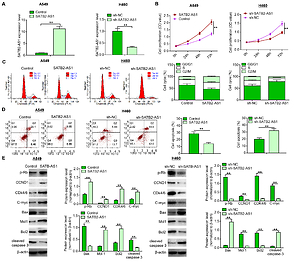Current issue
Archive
Manuscripts accepted
About the Journal
Editorial office
Editorial board
Abstracting and indexing
Subscription
Contact
Ethical standards and procedures
Most read articles
Instructions for authors
Article Processing Charge (APC)
Regulations of paying article processing charge (APC)
ONCOLOGY / EXPERIMENTAL RESEARCH
SATB2-AS1 acts as a miR-299-3p sponge to facilitate tumorigenesis in human non-small cell lung cancer
1
Taihe Affiliated Hospital of Hubei University of Medicine, Taihe, China
Submission date: 2019-12-30
Final revision date: 2020-03-03
Acceptance date: 2020-03-18
Online publication date: 2021-04-05
KEYWORDS
TOPICS
ABSTRACT
Introduction:
Non-small cell lung cancer (NSCLC), the most common pathological type of lung cancer, is partly responsible for the increasing number of tumor-related deaths worldwide. This study aimed to explore the biological role of the anti-sense transcript of special AT-rich sequence binding protein 2 (SATB2-AS1), a novel cancer-related long non-coding RNA (lncRNA), and illustrate the potential molecular mechanisms.
Material and methods:
The expression patterns of SATB2-AS1 were determined via qPCR analysis in clinical samples and tumor cell lines. Kaplan-Meier survival analysis was conducted to assess the relationship between SATB2-AS1 expression and survival time of NSCLC patients. NSCLC tumors were transfected with SATB2-AS1 expression vectors or specific short hairpin RNAs (sh-SATB2-AS1). Tumor cell proliferation, cell cycle progression and apoptosis were detected by MTT assays and the flow cytometric method. Nude mouse transplantation models were applied to investigate the effects of SATB2-AS1 on tumor cell growth in vivo. Bio-informatics analysis, luciferase reporter assays and rescue assays were performed to elucidate possible molecular mechanisms.
Results:
SATB2-AS1 up-regulation was observed in tumorous tissues and cell lines. Up-regulated SATB2-AS1 expression was associated with shorter overall survival time of patients. SATB2-AS1 over-expression facilitated tumor cell proliferation, cell cycle progression and survival, while its knockdown inhibited tumor cell proliferation, cell cycle progression and survival. SATB2-AS1 depletion suppressed tumor growth in vivo. SATB2-AS1 was revealed to act as a miR-299-3p sponge to exert a carcinogenic effect.
Conclusions:
Our data indicate that SATB2-AS1 acts as a miR-299-3p sponge to facilitate NSCLC development, providing a novel candidate therapeutic target for NSCLC.
Non-small cell lung cancer (NSCLC), the most common pathological type of lung cancer, is partly responsible for the increasing number of tumor-related deaths worldwide. This study aimed to explore the biological role of the anti-sense transcript of special AT-rich sequence binding protein 2 (SATB2-AS1), a novel cancer-related long non-coding RNA (lncRNA), and illustrate the potential molecular mechanisms.
Material and methods:
The expression patterns of SATB2-AS1 were determined via qPCR analysis in clinical samples and tumor cell lines. Kaplan-Meier survival analysis was conducted to assess the relationship between SATB2-AS1 expression and survival time of NSCLC patients. NSCLC tumors were transfected with SATB2-AS1 expression vectors or specific short hairpin RNAs (sh-SATB2-AS1). Tumor cell proliferation, cell cycle progression and apoptosis were detected by MTT assays and the flow cytometric method. Nude mouse transplantation models were applied to investigate the effects of SATB2-AS1 on tumor cell growth in vivo. Bio-informatics analysis, luciferase reporter assays and rescue assays were performed to elucidate possible molecular mechanisms.
Results:
SATB2-AS1 up-regulation was observed in tumorous tissues and cell lines. Up-regulated SATB2-AS1 expression was associated with shorter overall survival time of patients. SATB2-AS1 over-expression facilitated tumor cell proliferation, cell cycle progression and survival, while its knockdown inhibited tumor cell proliferation, cell cycle progression and survival. SATB2-AS1 depletion suppressed tumor growth in vivo. SATB2-AS1 was revealed to act as a miR-299-3p sponge to exert a carcinogenic effect.
Conclusions:
Our data indicate that SATB2-AS1 acts as a miR-299-3p sponge to facilitate NSCLC development, providing a novel candidate therapeutic target for NSCLC.
Share
RELATED ARTICLE
We process personal data collected when visiting the website. The function of obtaining information about users and their behavior is carried out by voluntarily entered information in forms and saving cookies in end devices. Data, including cookies, are used to provide services, improve the user experience and to analyze the traffic in accordance with the Privacy policy. Data are also collected and processed by Google Analytics tool (more).
You can change cookies settings in your browser. Restricted use of cookies in the browser configuration may affect some functionalities of the website.
You can change cookies settings in your browser. Restricted use of cookies in the browser configuration may affect some functionalities of the website.



